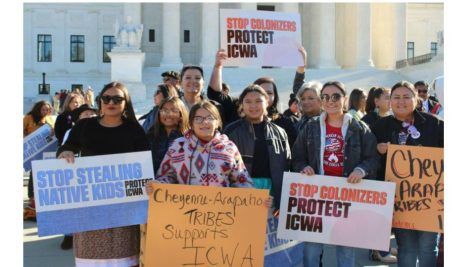The Challenging of ICWA in the Supreme Court: What It Means and What You Need to Know
April 28, 2023
 Image from Workers World
Image from Workers World
On November 8, 2022, the Supreme Court issued that it will be hearing Haaland v. Brakeen, a lawsuit that seeks to overturn the feudal legislation known as the Indian Child Welfare Act (ICWA). The statute governs the removal and placement of indigenous children. This ruling may determine the fate of Native American familial rights.
The Haaland v. Brackeen case originated in Texas after a white, evangelical couple Jennifer and Chad Brackeen failed to adopt a now 4-year-old Navajo girl due to the Indian Child Welfare Act. In 2016, the Brackeens fostered a 9-month-old boy identified in court records as A.L.M who they later adopted. Nevertheless, everything changed in 2018 when A.L.M.’s biological mother gave birth to his half-sister identified in the records as Y.R.J.. The couple battled for Y.R.J.’s custody, claiming that the ICWA discriminates against white people. The New York Post stated, “There’s a law that’s affecting us that’s risking the established bonding and attachment and loving home that our children find themselves in because of their Indianness.” Although the Navajo Nation is working to place the young Navajo girl named Y.R.J. with a distant family member in her tribe, the Brackeens are backed up by a strong legal team in the fight over her adoption.
In 1978, the ICWA was passed in response to the shockingly high number of Native Americans who were forcibly being taken from their tribes and families. According to NICWA, “25%–35% of all Native children were being removed; of these, 85% were placed outside of their families and communities—even when fit and willing relatives were available.” However, the current situation is that, as of November 2022, the ICWA is being challenged in the U.S. Supreme Court. It is a keystone case, meaning that if it is challenged, many other keystone cases may also be challenged due to the statute from this case. In addition to protecting children and ensuring their family unity and reunion, this case has sparked a massive legal battle with Native American rights.
The ICWA legislation was put into place to ensure safety and security in indigenous communities in cases where children were adopted outside of their tribes into an abusive environment. The abolition may lead to losing the last protections the indigenous people have to preserve their culture. Preserving these rooted values of indigenous culture and identity is given top importance by ICWA. It simply establishes a minimal criterion but is not the key factor in a child’s placement. The foster care system frequently results in “lost children”—children who have forgotten or lost their roots, leaving them disconnected. This puts indigenous culture at risk of mass cultural extinction.
Understanding residential schools is crucial to comprehending ICWA. These residential schools were (active/the norm) from the 1830s to the 1970s. Children between the ages of 4 and 16 were compulsorily sent to these schools by the U.S. government. According to National Post, “Indigenous children sent to residential schools were subjected to rape and molestation from principals, teachers, dormitory supervisors and even maintenance workers and janitors. At some schools, upwards of 70 percent of students faced some form of sexual abuse.” More than 70% of these young children endured some form of physical, sexual, or emotional abuse.
Since the government wanted to integrate the Native people into white society, the institutions wanted a white and Christian conversion. According to Harvard University, “Many of the European missionaries who energetically sought to spread Christianity to Native peoples were motivated by a sense of mission, seeking to bring the Gospel to those who had never had a chance to hear it, thereby offering an opportunity to be “saved.”” As the government puts it, they only tried to help Native children assimilate or make them “whiter.” To do so, the government sent tens of thousands of Native kids to these residential schools.
Furthermore, the residential schools kept the children malnourished and utilized their hunger as an experiment, forcing these children to eat spoiled foods and work as child laborers to support the schools. The children would face severe repercussions if they were to speak or even acknowledge their culture and identity. Most of the children died in the residential schools and many of them were buried in unmarked graves that are still being found today. So, if history repeats, revoking the ICWA may result in Native children in foster care being mistreated.
A former Grollier Hall Residential School resident in Inuvik, Northwest Territories, and a Dene victim, Norman Yakeleya shared his experiences with us: “When you’re hurt, especially by sexual abuse, as a young boy, you don’t talk about it. There’s a lot of shame. How can another man do that to you? And then try to live a good life as the Bible teaches us? How can you forgive that? Sometimes it doesn’t seem like there’s hope.” Several survivors who spoke out against the cruelties of the residential schools shared similar experiences.
The US Supreme Court will decide in June whether 9.7 million Native Americans will have parental rights to their children. If the Supreme Court deems ICWA to be unconstitutional, it may enact a bill that takes away the rights of Native Americans and their children. This case will have a significant impact on all Native American communities and tribal sovereignty.
